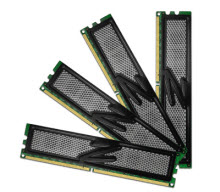Vista struggling? OCZ launch 8GB and 16GB upgrade kits

Feel like your PC could do with a little more RAM? OCZ, the California-based memory specialist, might have the answer - 8GB and 16GB upgrade kits!

Note: Even if using these kits to go up to 8GB or RAM you still need a compatible P43 or P45 chipsets boards because of the 4GB density of the modules.
Once you are tooled up with the right motherboard, next you need to have a 64-bit OS. These upgrade kits are targeted at Windows Vista users but I see no reason why they wouldn't be applicable to 64-bit Linux distros too.
Once you have the right motherboard and OS, you're ready for 4GB density modules!
In addition to the Vista upgrade kits, OCZ are also releasing low-latency Gold and Platinum kits.
Here are the kits available:
- OCZ PC2-6400 Platinum 8GB (2x4GB) Kit CL5-4-4-15 @ 1.8V
- OCZ PC2-6400 Gold 8GB (2x4GB) Kit CL5-5-5-15 @ 1.8V
- OCZ PC2-6400 Vista Upgrade 8GB (2x4GB) Kit CL5-6-6-18 @ 1.8V
- OCZ PC2-6400 Vista Upgrade 16GB (4x4GB) Quad Kit CL5-6-6-18 @ 1.8V
There's no official word on pricing yet, but expect to pay a premium price for these kits.
So, who needs this much RAM? Dr. Michael Schuette, vice president of technology development at OCZ, has this to say:
64-bit operating systems are becoming more mainstream and finally enable user memory to shed the 2GB limitation of 32-bit OS. Moreover, the latest multi-core systems are capable of simultaneous execution of highly complex workloads, each commanding its own virtual memory space. In that scenario, the only way of avoiding data collision without writing back to the hard disk is the migration toward super-high memory densities.
While it's great to see 4GB density modules appearing for the desktop market, I do have to point out that we're not at the point yet where +4GB is anywhere close to being mainstream. In fact, these kits will only be applicable to certain kinds of heavy users.
So, who's up for 16GB of RAM?